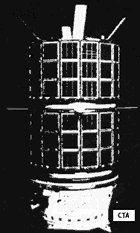MACSAT
Multiple Access Communications Satellites
 The two MACSAT spacecraft are third generation DSI digital communications satellites designed to demonstrate tactical UHF voice, data, fax and video store and forward capabilities for the U.S. military. The gravity gradient boom on one spacecraft appears to have failed to deploy. The other spacecraft was used during Operation Desert Storm for message relay to and from military troops in the Gulf region.
The two MACSAT spacecraft are third generation DSI digital communications satellites designed to demonstrate tactical UHF voice, data, fax and video store and forward capabilities for the U.S. military. The gravity gradient boom on one spacecraft appears to have failed to deploy. The other spacecraft was used during Operation Desert Storm for message relay to and from military troops in the Gulf region.
Spacecraft
Gravity gradient stabilized (approx. 5 degrees control) using a 9+ meter boom and 2.3 kg tip mass. Damping achieved via hysteresis rods. Z-coil used to invert the spacecraft should it stabilize upside down. Dual digital processors provide redundancy and 2.4 to 16 megabytes of data storage. 16 sided cylindrical structure. Body mounted solar cells provide 10 to 17 watts of orbit average power. Redundant NiCd batteries provide 150 Whr capacity.
Payload
Each satellite contains two digitally tunable 10 watt transmitters, a 65 watt high power auxiliary receiver for spacecraft command and hardware reconfiguration, and two antenna systems. This equipment was used to conduct store and forward communications demonstrations.
| Country of Origin | United States |
| Customer/User | DARPA |
| Manufacturer(s) | Defense Systems Inc. (now CTA) |
| Size | 61 cm diameter, 35.6 cm high |
| Orbit | 613 x 739 km, 90 deg inclination |
Launch Facts
| Name | Int'l Desig. | Date | Site | Vehicle | Orbit | Mass(kg) |
| Notes | ||||||
| Macsat 1 | 1990-043A | 5/9/90 | WSMC | Scout G1 | LEO | 68 |
| Multiple Access Communications Satellite; global store and forward communications | ||||||
| Macsat 2 | 1990-043B | 5/9/90 | WSMC | Scout G1 | LEO | 68 |
| Multiple Access Communications Satellite; global store and forward communications | ||||||
Information in The Mission and Spacecraft Library is provided without warranty or guarantee. USE AT YOUR OWN RISK.